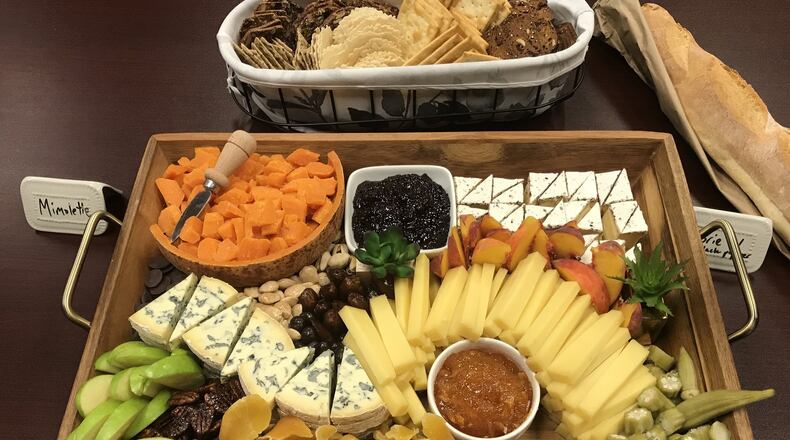A colleague recently ate a chunky morsel of bright orange mimolette cheese. He called it a “religious experience.” That description would bring a smile to the face of Charles Duque. The International Cheese Guild inductee and ambassador for French and other European cheeses wants everyone to eat more fine cheese.
So far, we Americans are doing a good job. Artisanal cheese is the leading category of specialty food sales in the U.S., noted Duque, who works as the North American director for the French Dairy Board and oversees programs to promote French dairy products, including Cheeses of Europe, a website and app that offers information about European cheeses available in this country.
Duque was recently in Atlanta representing Cheeses of Europe, a sponsor of the BB&T Open. He is fluent in four languages — five, if you count cheese. He can tell you why mimolette has that distinguished neon orange hue (annatto) and how it came into existence (at the request of Louis XIV, who was waging war against the Dutch and didn’t want French money going to support the enemy’s Edam).
Even if a cheese making or history lesson isn’t of interest to you, when you’re spending a pretty penny on fancy cheese for your next party, it pays to know how to select and serve it.
The best cheese plate is a celebration of flavors, textures, colors and aromas. Ideally, it showcases three to five cheeses that represent a variety of styles, from creamy soft to hard. The platter Duque presented was an assembly of four French cheeses, all made with cow’s milk: a nutty Comté; a luscious black-pepper speckled brie that tasted like a tripe crème thanks to a process of ultra-filtration that removes water from pasteurized milk; that sharp, nutty, butterscotch-y mimolette; and blue-veined Fourme d’Ambert.
Your local cheesemonger can suggest complementary flavors and textures to create a harmonious board (the Cheeses of Europe app includes a feature to help you design your own cheese plate with a mix of mild, medium, strong and bold cheeses). Plan on 4 to 6 ounces in total per person.
When purchasing cheese, watch for signs that a cheese is past its prime. These include strong aroma, plastic wrap that is starting to bubble, and cheese oozing out the side, Duque said. For peak freshness, shop for cheese close to the date you want to serve it.
Remove cheese from the fridge 30 minutes to one hour prior to serving it because the flavor and aroma of cold cheese is muted compared to when it is consumed at room temperature.
Even the way you slice the cheese can impact the experience. For example, pointed cheeses, such as brie, are best enjoyed when each slice has a bit of rind on it. Round cheeses like Camembert are more easily handled when cut into triangular wedges, as you would a pie. Pyramid- or cone-shaped cheeses should be cut all the way through to the height of the cheese.
Certain knives are specifically designed to cut certain kinds of cheeses. For example, a wide cheese knife is best for crumbly cheese, but a regular knife will do. Offer a spoon, though, with runny and spreadable cheeses.
If you want to be proper about arranging the board, set the cheese in a clockwise position from mildest to most pungent and complex, and with enough distance between them so that they don’t touch and are easy for guests to cut (if you are not serving it pre-portioned). Who wants to be first to cut into a beautiful intact wedge? No one. Guests will be less reticent to dive in, if you make the first cut, leaving a few nubs and crumbles on the plate.
Cheese is the star, but accompaniments bulk up the board and turn it into a stunning display. Plus, a range of sweet, salty and savory accompaniments can elevate the flavor of cheese, providing balanced contrast to the texture and notes in the cheese.
Duque’s display included marcona almonds, pickled okra, dates, dried mango and fresh peach slices, and spreadable condiments of cherry jam and peach chutney. (The accompanying recipe for Fig Mostarda is a fine match for goat cheese, blue cheese and brie.) The goods were presented on a rimmed tray, whose sides allowed for piling on the nibbles for a veritable cornucopia, with no space left bare.
What’s better with cheese, bread or crackers?
“I’m a purist,” Duque said. “I like to eat it on its own.”
Crostini, thin baguette slices, crackers — there’s no hard-and-fast rule, he said. If using crackers, though, select mild ones that won’t compete with the flavor of the cheese.
Wine is still the go-to beverage for pairing with cheese. In general, milder cheeses pair better with lighter wines while more robust cheeses are matches for bold wines. (Why not put heads together with your favorite wine shop and offer a selection of cheeses and wines from the same region?), but, noted Duque, “It’s not just wine and cheese anymore.”
There is a world of sippers that can complement cheese. He called craft beer “a great pairing” of two fermented products, noting that the bubbles from beer can serve as a fine palate cleanser. He ticked off other beverages: cider, coffee and tea, tequila, even sake.
“There’s no limit,” Duque said.
You want a really religious experience? Match that mimolette with whiskey.
Fig Mostarda
If using as part of a cheese board, fig mostarda is a good match for goat cheese, blue cheese and brie. The condiment can also be served with pates, bread, roasted meats and as a component in a salad dressing for crisp, bitter greens.
1 tablespoon yellow mustard seeds
1 tablespoon mustard powder
3 cups figs, tops removed
1 1/3 cups sugar
1/2 cup white wine
Juice of 1/2 an orange
1/2 tablespoon prepared horseradish (do not use cream-style prepared horseradish)
The night before, mix the mustard seeds, mustard powder and enough water (about 2 tablespoons) to create a slurry. Keep at room temperature in a closed container.
Combine the figs and sugar in a medium bowl. Stir well and let sit at least 1 hour (longer if possible).
Place the figs and sugar into a pot. Bring to a boil. Use a slotted spoon to remove the figs from the pot to a holding container.
Add the white wine and orange juice to the pot with the remaining liquid. Bring to a boil, then reduce the heat to a simmer. Reduce this liquid to a thick syrup.
Add the mustard paste and horseradish to the pot. Return to a boil.
Add the figs back to the pot and return to a boil.
Remove from heat and let cool. The mostarda will thicken further as it cools.
Mostarda will keep up to 2 weeks when stored in clean, lidded storage containers and refrigerated. It will keep up to 6 months when placed in jars and processed in a rolling water bath. Makes 3 cups.
Per tablespoon: 34 calories (percent of calories from fat, 4), trace protein, 8 grams carbohydrates, trace fiber, trace fat (no saturated fat), no cholesterol, 1 milligram sodium.
Recipe courtesy of Josh Galliano, innovation leader at Companion Baking in St. Louis.
RELATED:
Read more stories like this by liking Atlanta Restaurant Scene on Facebook, following @ATLDiningNews on Twitter and @ajcdining on Instagram.
About the Author
Keep Reading
The Latest
Featured




